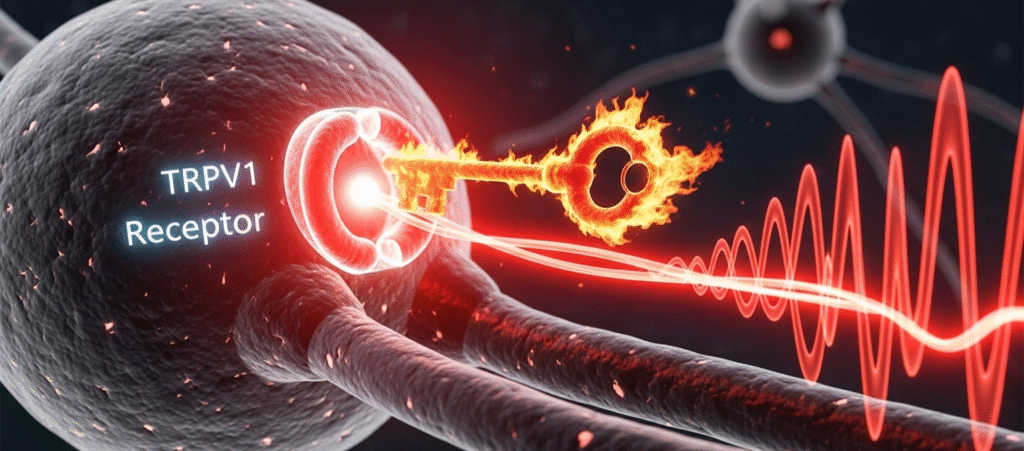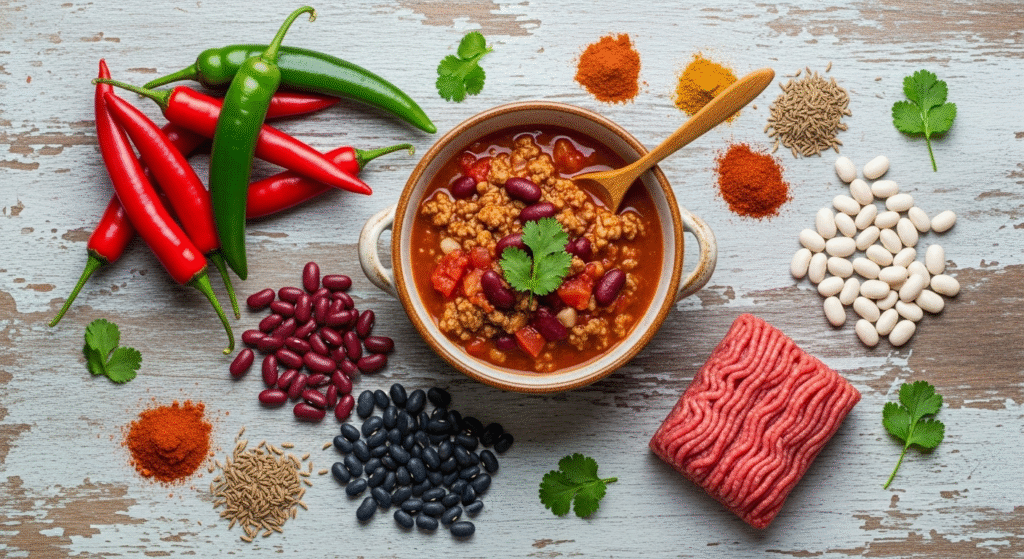Imagine it’s a perfect summer afternoon. You’re at a barbecue with friends, the grill is sizzling, and the table is loaded with fresh salads and cool drinks. You bite into a juicy piece of grilled pepper, and suddenly, an explosion of heat erupts in your mouth. Your eyes water, your face flushes, and you reach for a glass of water. A few minutes later, you take a sip of a mint-infused lemonade, and a wave of refreshing coolness washes over you. Both plants likely grew in the same garden, drinking the same water under the same sun. So, have you ever stopped and wondered why are peppers hot and mint is cool?
The answer isn’t magic; it’s a fascinating story of chemical trickery, evolutionary strategy, and the incredible way our own bodies interpret the world. It’s a journey that takes us from the humble garden plot deep into the microscopic wiring of our nervous system. We’re about to uncover how these plants play clever tricks on our senses, using special compounds like the capsaicin molecule to mimic heat and the menthol cooling effect to imitate cold, all without changing the temperature by a single degree.
The Fire Illusion
This oily molecule in peppers fits perfectly into your body’s nerve receptors called TRPV1. These receptors are designed to detect real heat above 43°C (110°F).
Capsaicin tricks the receptor into opening, sending a false “I’m burning!” signal to your brain.
The Cool Trick
This volatile oil in mint binds to a different set of receptors called TRPM8. These receptors are built to detect real cold temperatures below 25°C (77°F).
Menthol activates these receptors, fooling your brain into thinking the surface is getting colder.
The Fiery Deception: Unpacking the Capsaicin Molecule
The reason a jalapeño or habanero sends you running for relief is a powerful, sneaky compound. The entire sensation of heat from a pepper comes down to one star player: the capsaicin molecule.
Capsaicin is a colorless, odorless chemical found in all hot peppers. It’s concentrated most heavily in the white, pithy membrane that holds the seeds. When you chop a pepper and get that spicy oil on your hands, that’s capsaicin. It’s the reason why a pepper’s heat can feel so persistent and why it seems to get everywhere.
But this molecule doesn’t actually burn you in the way a hot stove would. It’s a master of disguise. Its real talent lies in its ability to trick your body into thinking it’s being burned.
The Body’s Alarm System: Meet the TRPV1 Receptor
To understand the trick, we need to meet a key character inside our own bodies: a special protein on our nerve cells called the Transient Receptor Potential Vanilloid 1, or TRPV1 receptor for short.
Think of the TRPV1 receptor as a tiny, heat-sensitive gatekeeper on your nerve endings. Its main job is to detect real heat. When you sip coffee that’s too hot or touch a warm pan, these gates fly open. They send an urgent message to your brain: “Danger! High temperature here!” Your brain interprets this signal as a burning sensation, and you react by pulling your hand away or spitting out the coffee. This receptor is a crucial survival tool, designed to protect you from actual burns. It’s programmed to activate at temperatures above 43°C (about 110°F).
Here’s where the trickery comes in. The capsaicin molecule has the exact right shape to fit perfectly into the TRPV1 receptor, like a skeleton key fitting into a lock it wasn’t designed for. When capsaicin binds to this receptor, it forces the gate open, even though there’s no real heat.

The nerve cell doesn’t know the difference. All it knows is that the gate is open, so it sends the same frantic “I’m burning!” signal to your brain. Your brain, in turn, reacts exactly as it would to a real burn. It makes your mouth feel like it’s on fire, triggers your sweat glands to cool you down, and sends blood rushing to the area, causing your face to turn red. This explains why are peppers hot it’s a brilliant, harmless illusion.
Why Drinking Water Makes It Worse
What’s the first thing everyone does when their mouth is on fire from a spicy dish? They grab a glass of water. Unfortunately, this is one of the worst things you can do.
Remember how we said the capsaicin molecule is an oil-based compound? Well, oil and water don’t mix. When you drink water, it doesn’t dissolve the capsaicin. Instead, it just sloshes the oily capsaicin all around your mouth, spreading the “fire” to new, untouched nerve endings. It’s like trying to put out a grease fire with water it only spreads the problem. Scientific American
So, what’s the solution? You need something that can dissolve or lift away the oily capsaicin. This is where dairy products shine. Milk, yogurt, and ice cream contain a protein called casein, which is a lipophilic (fat-loving) molecule. Casein surrounds the capsaicin molecule and washes it away, providing genuine relief. Sugary drinks and starchy foods like bread or rice also help by creating a physical barrier between the capsaicin and your pain receptors.
The Cool Illusion: The Magic of the Menthol Cooling Effect
Now, let’s switch gears from the fire to the ice. On the opposite end of the spectrum is the delightful chill we get from mint. This sensation is caused by another clever compound: menthol.
The menthol cooling effect is just as much of a trick as capsaicin’s heat, but it targets a different set of gatekeepers in our nervous system. While capsaicin hijacks our heat detectors, menthol plays with our cold detectors.

The Cold Sensor: Activating the TRPM8 Receptor
Just as we have a TRPV1 receptor for heat, we also have a specific receptor for cold, known as TRPM8. Its job is to tell your brain when you come into contact with something genuinely cold, like an ice cube or a cold winter breeze.
Menthol has the perfect chemical structure to bind to this TRPM8 receptor. When you chew a piece of mint gum or drink a mojito, the menthol molecules lock onto these cold receptors and activate them. The nerve cell sends a signal to your brain that says, “It’s getting chilly in here!”
Your brain interprets this as a refreshing, cooling sensation, which is why the menthol cooling effect feels so pleasant, especially on a hot day. It’s the same mechanism, just a different receptor and a different illusion. It’s another perfect example that helps us understand the broader question of why are peppers hot and their garden neighbors are cool it’s all about which receptor is being tricked.
The menthol cooling effect is so effective that it’s used in countless products, from toothpaste and mouthwash to muscle rubs and cough drops, all designed to create that signature feeling of clean, cool relief.
Nature’s Master Plan: An Evolutionary Arms Race
This hot-and-cold chemistry isn’t just a fun party trick. It’s the result of millions of years of evolution, and it serves a very important purpose for the plants themselves. These compounds are, first and foremost, a brilliant defense mechanism.
You might be asking, if the goal is to explain why are peppers hot, what does that have to do with evolution? Everything. Plants can’t run away from things that want to eat them, so they developed chemical warfare instead.
Keeping Mammals Away
The primary targets of capsaicin’s fiery wrath are mammals like us, squirrels, and rabbits. When a mammal eats a pepper, its molars grind the seeds into oblivion, destroying the plant’s next generation. The intense burning sensation from the capsaicin molecule binding to the TRPV1 receptor is an incredibly effective deterrent. A squirrel might try a spicy pepper once, but it won’t try it a second time. This ensures the plant’s precious seeds survive.

Welcoming the Birds
But here’s where the story takes a turn of evolutionary genius: birds are completely immune to capsaicin. This incredible fact is the key to understanding the deeper biological reason why are peppers hot. It’s not just about heat; it’s about survival. While a mammal will take one bite of a spicy pepper and flee in pain, birds can eat the hottest peppers in the world and not feel a thing. This isn’t an accident; it’s a brilliant, targeted strategy millions of years in the making.
The secret lies in their internal wiring. The avian version of the TRPV1 receptor, the very protein that screams “fire!” in mammals, has a slightly different structure in birds. This subtle difference is a complete game-changer. It means the capsaicin molecule simply can’t bind to it. It’s like trying to fit a square key into a round lock it just floats on by without triggering the alarm. For a bird, the capsaicin molecule is completely invisible, having no more effect than water.
This creates a perfect partnership, a natural contract between the pepper plant and the bird. The plant invests its energy into producing the fiery capsaicin molecule as a highly specific defense system. It effectively puts up a “No Mammals Allowed” sign. It does this because mammals, with their powerful molars, grind up the pepper’s precious seeds, destroying any chance for the next generation. The burning sensation triggered in the mammalian TRPV1 receptor ensures that they learn their lesson quickly and leave the plant alone.
Birds, on the other hand, are the ideal guests. They don’t have teeth to crush the seeds. They swallow the fruits whole, and the seeds pass through their digestive systems completely unharmed. They then fly off, sometimes for miles, and deposit the seeds in a new location, complete with a small, personal packet of fertilizer. This allows the pepper plant to spread its offspring over a wide area, conquering new territories and avoiding competition with its parent. In essence, the plant uses the capsaicin molecule to select the perfect delivery service.
This elegant evolutionary strategy, which hinges on the specific interaction between the capsaicin molecule and the TRPV1 receptor, is the most profound answer to the question of why are peppers hot. The heat is a language that only certain creatures can understand, and it’s a message designed to ensure the future.
More Than Just a Kick: 4 Surprising Spicy Food Benefits
For humans, who have learned to endure and even enjoy the heat, these chemical weapons come with a host of incredible health perks. The very mechanisms that cause the burn also unlock a range of spicy food benefits.
- A Natural Painkiller: It seems counterintuitive, but the compound that causes pain can also relieve it. When applied to the skin in a cream, the capsaicin molecule repeatedly activates the TRPV1 receptor until the nerve endings are depleted of their pain-signaling chemicals. This provides effective, localized relief for arthritis and muscle soreness.
- A Boost to Your Metabolism: The rush of heat you feel after eating a spicy meal isn’t just in your head. It slightly raises your body’s core temperature, which in turn gives your metabolism a temporary boost, helping you burn a few extra calories. Some studies suggest it can also help reduce appetite.
- Heart-Healthy Properties: Regular consumption of spicy foods has been linked to better cardiovascular health. The spicy food benefits include helping to reduce bad cholesterol (LDL), lower blood pressure, and improve circulation, all of which contribute to a healthier heart. The workhorse behind this is, again, the incredible capsaicin molecule.
- Antimicrobial and Anti-inflammatory Effects: Before modern refrigeration, cultures in hot climates used spices heavily to preserve food. That’s because capsaicin has natural antimicrobial properties that can help kill harmful bacteria. This is one of the most ancient spicy food benefits. Internally, it also acts as an anti-inflammatory agent, helping to calm irritation in the body.

The same story applies to the menthol cooling effect. It’s not just for flavor. It acts as a mild anesthetic, which is why it soothes a sore throat. It also helps relax muscles in the digestive tract, providing relief for issues like indigestion and IBS. The spicy food benefits have a cool counterpart!
Conclusion: The Flavorful World Inside Our Food
So, the next time you take a bite of a fiery chili or sip a cool mint tea, you’ll know the secret. The reason why are peppers hot and mint is cool lies in two different molecules capsaicin and menthol performing two different, yet equally brilliant, chemical tricks.
They are masters of illusion, hijacking our body’s own sensory receptors to create sensations that aren’t really there. The capsaicin molecule convinces our TRPV1 receptor that we’re burning, while the menthol cooling effect tells our TRPM8 receptor that we’re freezing.
This fascinating tale of flavor, defense, and deception is a wonderful reminder that the natural world is full of hidden chemistry. What started as a plant’s weapon in an evolutionary arms race has become a source of culinary delight and powerful spicy food benefits for us. It’s a beautiful, complex, and delicious interaction, proving that even in a simple garden, there are endless wonders waiting to be discovered.

Feeling paralyzed by endless options? You’re not alone. The secret to a decisive life isn’t about finding the perfect choice, but mastering the process. Discover how to turn confusion into confidence and finally take control of your decisions with a clear, calm mind. To learn more, visit The Art of Decision-Making.












